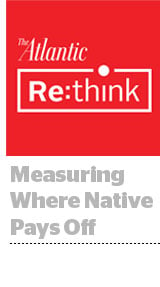 Native is a big deal to The Atlantic, where sponsored content will comprise 75% of digital revenue this year.
Native is a big deal to The Atlantic, where sponsored content will comprise 75% of digital revenue this year.
It employs a 30-person team, dubbed Atlantic Re:think, to create campaigns for clients like Porsche, TIAA and Cathay Pacific. The team operates with the philosophy that “engagement is an art and science,” said Michael Monroe, the head of Re:think.
As native advertising moves from the experimental section of brand budgets to a core part of their marketing campaigns, both agencies and publishers are upping their requirements for how they measure native. They want more science.
With the goal of bringing in more data to back up its hunches, The Atlantic began by testing a hypothesis: Readers respond most to highly visual, interactive sponsored posts, such as Porsche’s “The Science of a Thrill.”
Re:think turned to its social analytics partner, SimpleReach, to determine if high-production pieces perform better. First, The Atlantic tagged all articles published over the past year to separate those with strong visuals and high production value from those without. SimpleReach then compared the two groups with the averages of other SimpleReach clients over the past year.
The results of the test confirmed that the high production value pieces yielded better performance. Average engaged time rose 102% compared to industry averages. Total engaged time soared 118% and social shares spiked 302%.
While doubling engagement time, as the high-impact Atlantic Re:think pieces did, sounds great, being able to benchmark success of sponsored content campaigns remains a challenge. Advertisers still struggle to add discipline to their metrics and deduce which sponsored content campaigns perform well, Monroe said.
While advertisers know what constitutes a good or bad click-through rate, they don’t understand what it means if someone views 55% of a video.
“We are constantly asked for benchmarks,” Monroe said. “We have to be as competitive [as banner ads] in showing ROI.”
However, many newly designed programs don’t have anything to compare to.
“Often the program we launch is the first of its kind, making it hard to benchmark an industry that is moving so quickly,” Monroe said.
AdExchanger Daily
Get our editors’ roundup delivered to your inbox every weekday.
Daily Roundup
SimpleReach, which works with both advertisers and publishers, observes this dynamic as well: Advertisers want to know what to measure and benchmark even as innovations in sponsored content make those benchmarks irrelevant. Advertisers also want to measure more parts of content campaigns instead of focusing on one-dimensional metrics, such as page views.
“There isn’t a magic bullet when it comes to understanding how content works,” said Amit Dodeja, strategy VP of SimpleReach. “Display can fall back on click-through, but understanding content is peeling an onion.”
The social measurement company is responding by adding more ways to slice and dice its data. Using natural language processing, it plans to give publishers a view into performance by content type since engagement with business articles differs from engagement in arts and entertainment articles.
Plus, that same granularity of data that advertisers crave helps publishers create better content.
“As measurement has become more sophisticated,” Monroe said, “that’s created a feedback cycle that influences design for future programs.”













